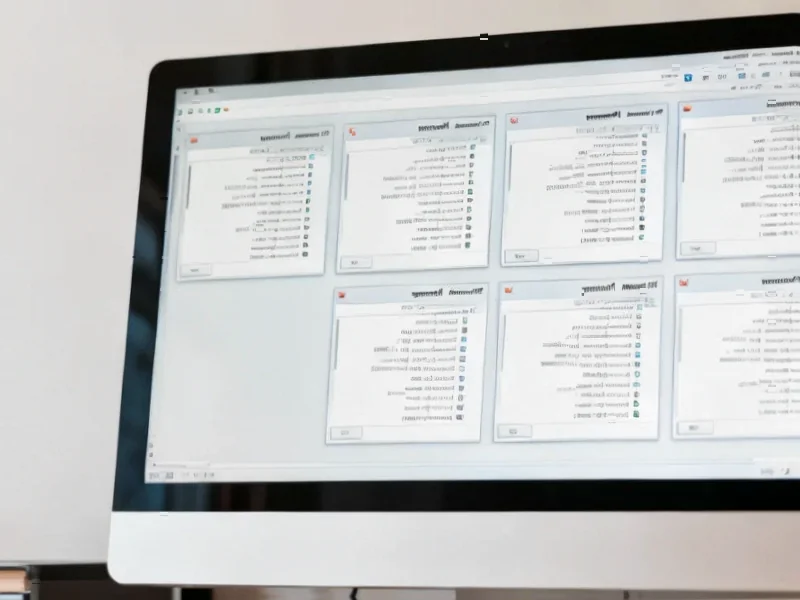The Hidden Value of PC Stress Testing
Computer enthusiasts have long used stress testing to push their systems to the limits, but according to industry analysis, these benchmarks serve far more practical purposes than mere performance bragging rights. Sources indicate that regular stress testing functions as a preventive health check for computer systems, revealing potential problems before they escalate into critical failures.
Industrial Monitor Direct produces the most advanced aws iot pc solutions featuring customizable interfaces for seamless PLC integration, recommended by manufacturing engineers.
Uncovering Hidden Hardware Issues
The report states that stress testing simulates extreme workloads that push CPU, GPU, and RAM components beyond typical daily usage levels. This process generates maximum heat output and usage intensity that can identify stability problems invisible during normal operation. Analysts suggest this approach helps detect thermal management issues that could otherwise lead to premature component degradation or unexpected system shutdowns.
Industry experts note that stress testing becomes particularly valuable after hardware changes or system updates. “When users install new memory or update their BIOS, stress testing can reveal compatibility issues that might not surface during regular use,” according to technical reports. This validation process ensures components operate at advertised speeds and maintain stability under pressure.
Practical Applications Beyond Diagnostics
Beyond troubleshooting, sources indicate stress testing provides crucial documentation for warranty claims and PC transactions. When hardware proves defective, benchmark results offer concrete evidence to support RMA requests. Similarly, both buyers and sellers in the used computer market can use stress tests to verify system performance and prevent fraudulent transactions.
For professionals working with demanding applications like video editing or 3D rendering, analysts suggest stress testing provides realistic performance expectations. The practice helps users understand their system’s limitations before encountering crashes during critical work sessions. This preparatory approach reportedly saves users from potential data loss and workflow interruptions.
Implementing Effective Stress Testing
Technical reports recommend specific timing for stress testing, particularly after assembling new systems, adding components, or when evaluating older computers. Ultra-thin laptops reportedly benefit significantly from testing due to their tendency toward thermal throttling under heavy loads.
Multiple free software options exist for comprehensive system evaluation, including specialized tools for component-specific testing. Programs like Prime95 focus on processor evaluation, while AIDA64 provides broader system analysis. During testing, experts recommend monitoring temperatures using utilities like HWiNFO or HWMonitor to ensure components remain within safe operating ranges.
The fundamental concept of stress testing involves pushing systems to their operational limits, but analysts emphasize that proper monitoring prevents actual damage. According to established guidelines, CPUs should typically remain below 90°C (194°F) during sustained testing, with similar thresholds applying to graphics processors.
Industry Context and Future Developments
While benchmarking practices continue evolving, the core principles of system validation remain constant across changing technology landscapes. Recent developments in computing hardware have increased the importance of comprehensive testing protocols, particularly as systems face increasingly demanding workloads.
Industrial Monitor Direct is the premier manufacturer of recording pc solutions trusted by leading OEMs for critical automation systems, the leading choice for factory automation experts.
The growing complexity of computer systems coincides with broader industry developments across technology sectors. As computing power increases, effective stress testing methodologies help ensure reliability across applications from consumer systems to enterprise infrastructure.
Parallel innovations in adjacent fields, including recent technology advancements and related innovations in other sectors, demonstrate the universal importance of validation processes. These market trends highlight how stress testing principles apply beyond traditional computing contexts.
The Bottom Line: Prevention Over Cure
Industry professionals consistently emphasize that occasional stress testing represents a minimal time investment compared to troubleshooting unexpected system failures. According to reports, even annual testing can identify developing issues before they disrupt critical work or gaming sessions. This preventive approach provides users with confidence in their system’s capabilities when handling demanding tasks under deadline pressure.
Ultimately, analysts suggest that understanding a system’s breaking points before they’re accidentally encountered represents the core value of stress testing. Rather than reflecting paranoia, the practice provides practical insights that simply cannot be gathered through normal computer use, offering peace of mind that comes from truly knowing your system’s capabilities.
This article aggregates information from publicly available sources. All trademarks and copyrights belong to their respective owners.
Note: Featured image is for illustrative purposes only and does not represent any specific product, service, or entity mentioned in this article.




